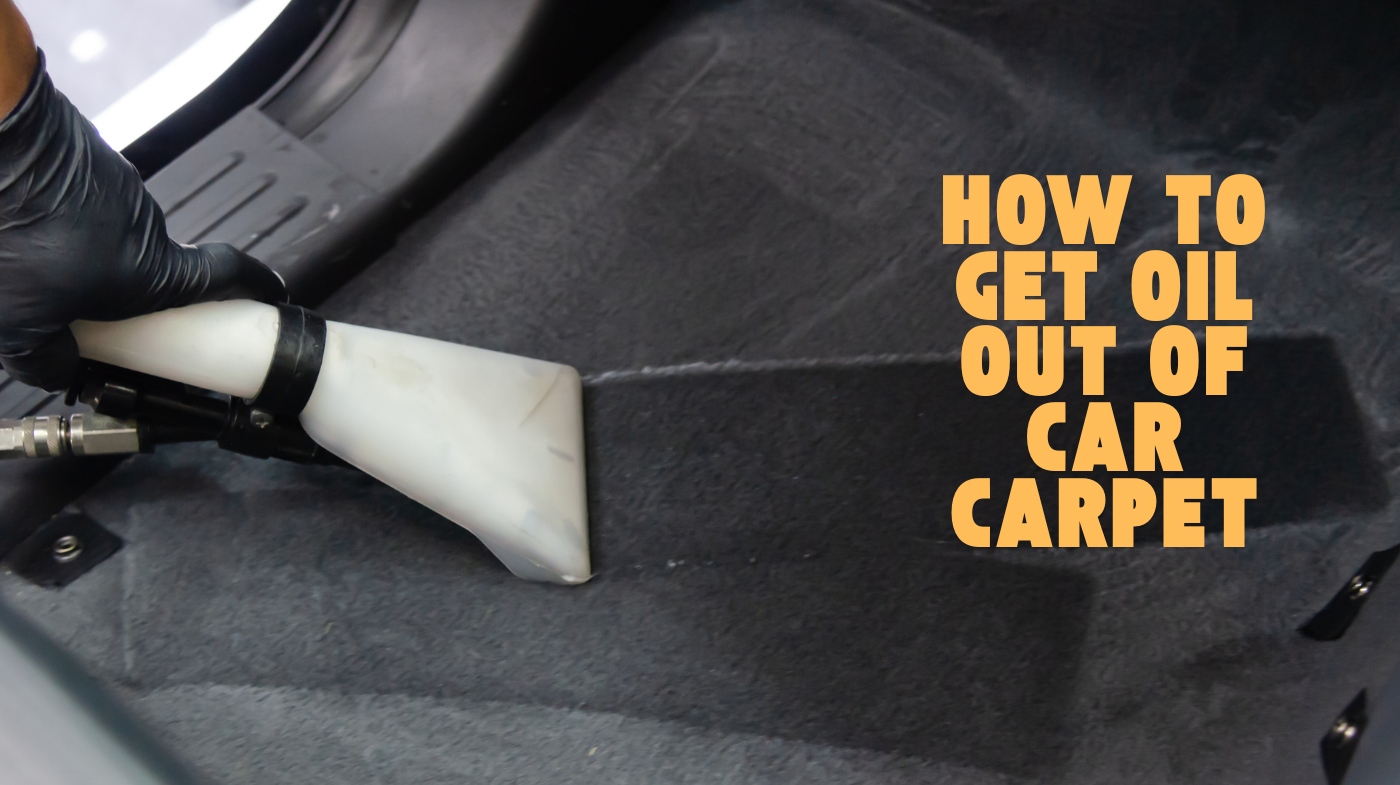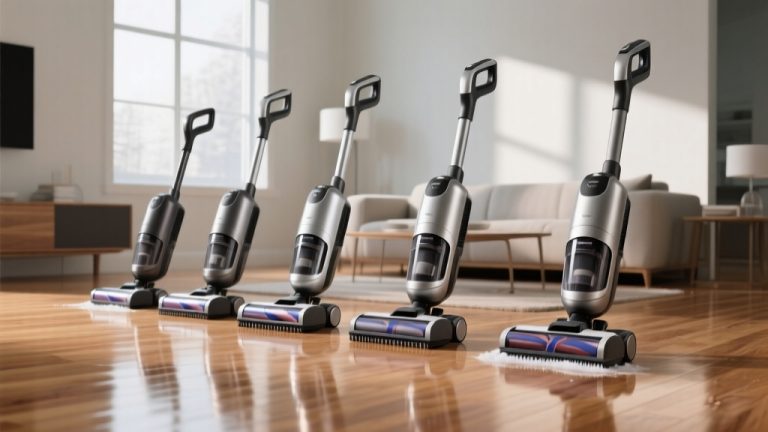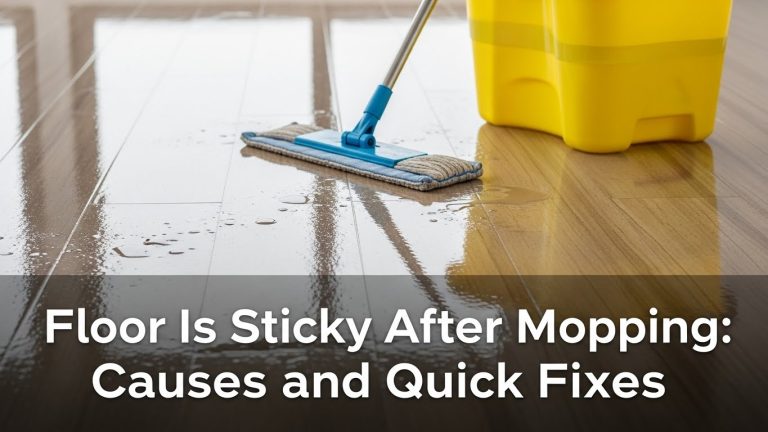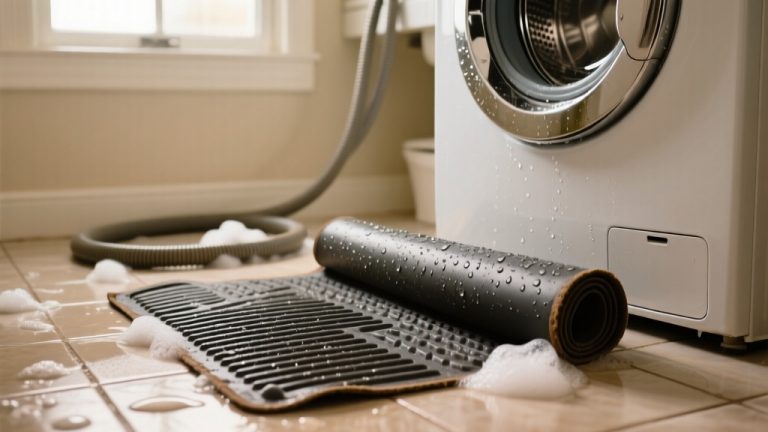How to Get Oil Out of Car Carpet? A Safe, Gentle Method
To get oil out of your car carpet, first blot excess oil gently with paper towels without rubbing. Sprinkle absorbent powders like baking soda or cornstarch over the stain to soak up remaining oil, letting it sit for at least 30 minutes before vacuuming.
Then, apply a mild detergent solution to emulsify the grease and rinse with clean water. Avoid harsh scrubbing or chemicals to protect fibers. If you need more detailed steps or product recommendations, keep exploring further solutions.
Key Takeaways
- Blot excess oil immediately with paper towels without rubbing to prevent deeper carpet absorption.
- Sprinkle baking soda or cornstarch on the stain for 30 minutes to absorb oil and odors, then vacuum thoroughly.
- Apply a mild detergent solution with warm water to emulsify grease, gently blot, then rinse carefully with clean water.
- Use absorbent materials like microfiber cloths or kitty litter to soak up fresh oil spills quickly before cleaning.
- Repeat cleaning steps if needed and allow the carpet to dry completely to prevent mold or lingering stains.
Immediate Steps to Take After an Oil Spill on Car Carpet
When you notice an oil spill on your car carpet, act immediately to prevent the stain from penetrating deeper into the fibers.
Avoid rubbing or scrubbing, as this spreads the oil and embeds it further. Instead, gently blot excess oil with kitchen paper towels or a clean microfiber cloth using firm, vertical pressure, as microfiber cloths are excellent at absorbing dirt and grime without streaks.
For thick or sticky oil, carefully scrape off surplus with a spoon or spatula before blotting. Change blotting materials frequently to maintain absorbency and prevent transfer.
Sprinkle a thick layer of absorbent powder—like baking soda or cornstarch—over the spill, letting it sit for at least 30 minutes to draw out the oil. Vacuum thoroughly afterward.
Always check your carpet’s manufacturer instructions and test any treatment in a hidden area to avoid damage or discoloration.
Using absorbent powders is essential because oil is hydrophobic, repelling water and clinging to carpet fibers, making it difficult to remove.
Effective Homemade and Commercial Cleaning Solutions
Although oil stains on car carpets can be stubborn, you can effectively tackle them using a range of homemade and commercial cleaning solutions designed to break down and absorb petroleum-based residues.
Baking soda and cornstarch absorb excess oil, while mild detergent mixed with warm water emulsifies grease. For tougher stains, commercial cleaners like Woolite Heavy Traffic Cleaner or Miss Mouth’s Messy Eater Spray penetrate deeply to lift oil.
Use mineral spirits cautiously due to potential discoloration. It is important to blot excess oil promptly with a clean cloth to prevent deeper absorption before applying any cleaning agents.
| Solution Type | Key Feature |
|---|---|
| Baking Soda/Cornstarch | Absorbs oil and odors safely |
| Commercial Cleaners | Targeted enzymatic and solvent actions |
| Detergent Solutions | Mild surfactants emulsify and lift oil |
Choose agents based on stain severity and always spot test before full application.
Step-by-Step Cleaning Techniques for Oil Stains
Since oil stains can quickly penetrate car carpet fibers, you’ll need to act methodically to remove them effectively.
Start by scraping off excess oil with a dull knife, then blot fresh spills gently without rubbing. Acting immediately with a towel helps absorb excess oil to prevent setting.
Act quickly on oil stains by scraping excess oil and gently blotting fresh spills without rubbing.
Apply baking soda generously, let it absorb oil for 10–15 minutes, then vacuum it thoroughly.
Next, blot the stain with rubbing alcohol using a cloth—avoid wiping to prevent spreading. Repeat if needed, but don’t oversaturate.
Prepare a mild detergent solution (1 quart cold water, 1/4 teaspoon dish soap), apply it gently with a sponge, blot until the stain diminishes, then rinse by blotting with clean water.
Use steam carefully to loosen embedded oil, blotting after each pass, and ensure proper ventilation.
Finally, air dry completely and inspect for residual stains before considering repetition or professional cleaning.
Best Absorbent Materials to Use on Fresh Oil Spills
Choosing the right absorbent material immediately after an oil spill can considerably reduce staining and ease cleanup.
For fresh oil spills on car carpet, hydrophobic synthetic materials like polypropylene pads are highly effective, absorbing many times their weight in oil without soaking water.
Laminated or fine fiber polypropylene pads offer increased absorption for larger or hydrocarbon-rich spills. These mats are typically designed with a layered construction to trap oil while repelling water, enhancing their effectiveness.
The porosity and surface texture of the absorbent influence how well it captures and retains oil, similar to how granite’s porosity affects stain absorption.
If you prefer natural options, use cellulose-based materials, cotton, wool fibers, or sawdust; these provide good absorption and biodegradability.
Household items like non-clumping clay kitty litter, baking soda, or old towels can quickly blot excess oil to prevent deeper penetration.
Avoid spreading the stain by gently applying absorbents rather than rubbing. Selecting absorbents with high oil affinity and quick wicking enhances your chances of removing oil before it sets.
Tips for Preventing Oil Stains on Car Carpets
To prevent oil stains on your car carpets, you should establish protective measures in areas most vulnerable to spills and contamination. Install rubber or plastic floor mats with anti-slip backing over carpeted zones prone to oil exposure.
Use disposable absorbent pads around maintenance areas to capture drips before they reach the carpet. Employ seat covers where oily hands or tools frequently contact upholstery, and replace barriers promptly when worn or saturated.
Maintain frequent vacuuming and schedule deep cleanings to prevent oil buildup. Pre-treat carpets with automotive stain repellents and apply fabric sealants designed for oil resistance. Regular maintenance and prompt cleaning helps avoid persistent stains that can become difficult to remove.
Educate drivers to use gloves or clean hands during maintenance and designate containers for oily tools. Acting immediately after an oil spill is crucial to prevent the stain from being absorbed into carpet fibers, which significantly improves removal success (prompt action).
Handling Different Types of Oil Stains in Your Vehicle
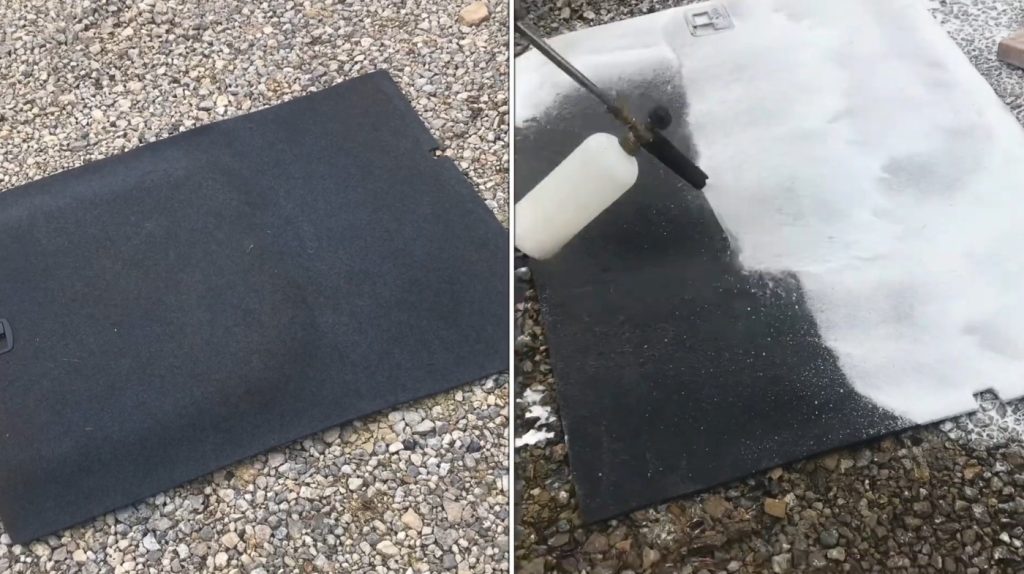
While prevention reduces the risk of oil stains, knowing how to handle various types that do occur improves your cleanup effectiveness.
Motor oil requires strong degreasers due to its thickness and darkness, while cooking oils respond well to dishwashing liquid and warm water.
Transmission fluid, with its distinct red or brown hue, needs prompt blotting and absorbent powders to prevent permanent discoloration. After initial blotting, it is helpful to sprinkle cornstarch or baking soda over the stain to absorb remaining oil effectively.
Understanding oil types boosts cleanup success; motor oil demands strong degreasers, cooking oils need mild soap, transmission fluid requires quick action.
- Blot excess oil immediately to avoid deeper fiber penetration, then apply baking soda or talcum powder for absorption.
- Use a dull knife to remove sticky grease carefully before cleaning.
- Test carpet stain removers on hidden areas and consider steaming for stubborn stains.
Frequently Asked Questions
Can Oil Stains Cause Long-Term Damage to Car Carpet Fibers?
Yes, oil stains can cause long-term damage to car carpet fibers. When oil penetrates, it bonds with synthetic fibers, making them stiff and brittle. Over time, it breaks down polymer chains, weakening structural integrity.
Oil also attracts dirt and moisture, promoting mold growth and discoloration. If you don’t act quickly, stains become permanent, causing matting and roughness. Regular maintenance and prompt cleaning help prevent this irreversible deterioration.
How Do Professional Car Detailers Remove Old Oil Stains?
When you’re dealing with old oil stains, professional detailers start by applying specialized, high-strength cleaners designed to penetrate deeply. They use soft brushes to agitate the stain gently.
Then, they follow up with steam cleaning or carpet extraction to lift embedded residues. You’ll notice they repeat these steps as needed, ensuring thorough removal while protecting fibers. Finally, they dry the area completely and often apply fabric protectors to prevent future staining.
Is It Safe to Use Enzyme-Based Cleaners on Synthetic Car Carpets?
Sure, you can confidently choose enzyme-based cleaners for synthetic car carpets. These cleaners carefully contain protease enzymes targeting protein stains without compromising synthetic fibers.
Just check the product’s safety for dyed materials and test a tiny, hidden spot first. Follow manufacturer guidelines precisely—dilution, dwell time, and gentle scrubbing—to prevent damage.
Avoid harsh chemicals or bleach. Once dry, your carpet stays safe, odor-free, and professionally pristine.
What Environmental Precautions Should I Take When Disposing of Oily Cleaning Materials?
When disposing of oily cleaning materials, you should use clean, leak-proof containers with secure lids to prevent spills. Store them in cool, ventilated areas away from heat and flammables.
Never pour oil down drains or onto soil. Separate oily waste from other trash to avoid contamination.
Take materials to authorized recycling centers or hazardous waste facilities. Follow local regulations closely, and regularly empty containers to minimize fire risks and environmental impact.
How Can I Prevent Oil Stains When Transporting Oily Tools or Parts in My Car?
You can prevent oil stains by placing heavy-duty plastic sheets or oil-proof mats over your car carpets before transport. Always wipe down oily tools to remove excess oil and wrap them in absorbent rags or paper towels.
Use sealed, leak-proof containers or toolboxes to secure oily parts. Line cargo areas with protective covers, use non-slip liners to keep items stable, and separate oily tools from other cargo to minimize contamination risk.
Keep Your Car Carpet Oil-Free with Smart, Quick Action
You’ll tackle oil stains effectively by acting quickly, applying the right absorbents, and choosing suitable cleaning solutions.
You’ll protect your car carpet by following precise techniques, using both homemade and commercial products, and addressing different oil types accordingly.
You’ll prevent future stains by maintaining regular care, being cautious during oil changes, and promptly treating any spills.
By combining speed, accuracy, and consistency, you’ll keep your car carpet clean and oil-free with confidence.

